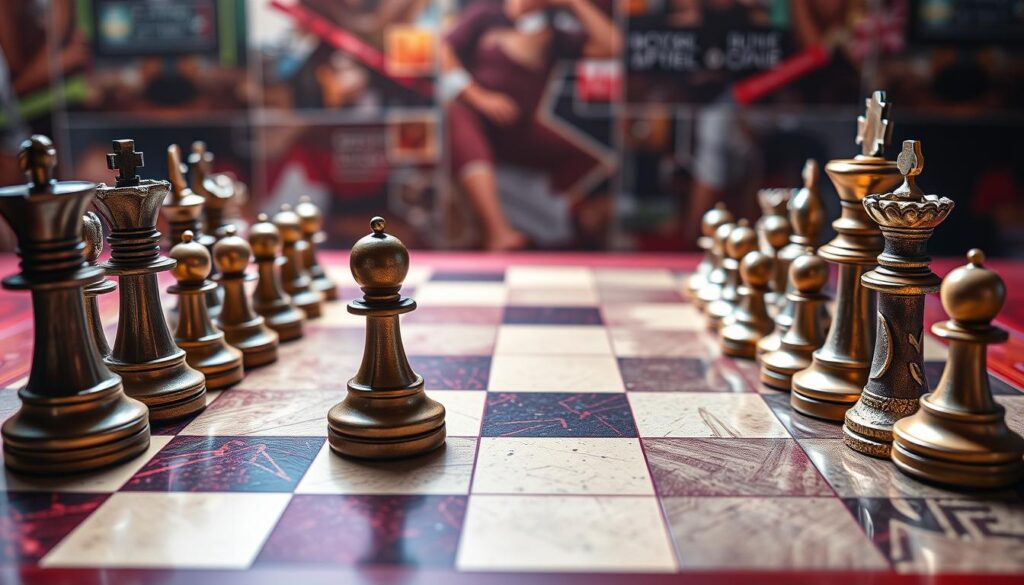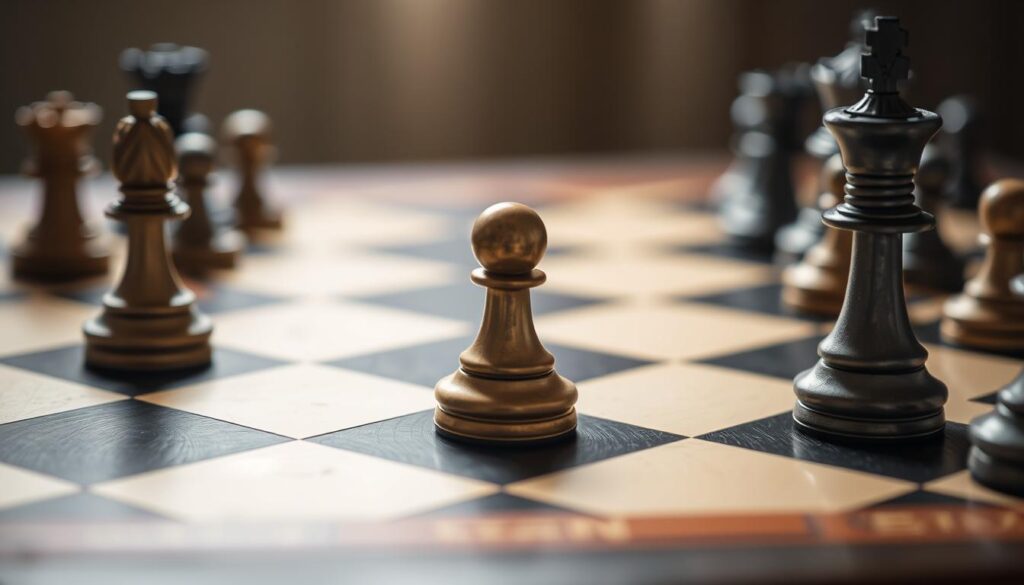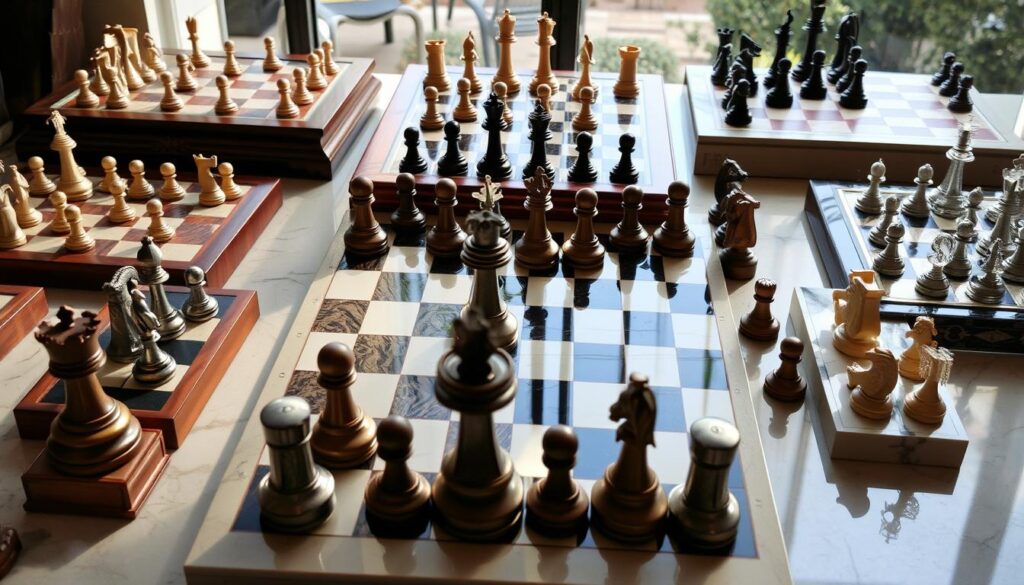As you look at the chessboard, you see 64 squares waiting to be explored. These squares are the heart of the game, no matter if you’re a pro or just starting. Let’s dive into the secrets of the chessboard’s design together
Table of Contents
Understanding the Basics of Chess Squares
Chess squares are the basic units of the chessboard, where the game is played. The game is set on an 8×8 board, with 64 squares in alternating colors. This setup is key to the game’s strategy.
What Are Chess Squares?
Each square on the board has its own spot, marked by a letter and a number. This system, known as algebraic notation, helps track moves and discuss strategies. It’s vital for grasping the game’s depth.
The 8×8 Board Configuration
- The chessboard has 64 squares, in 8 rows and 8 columns.
- Rows are numbered 1 to 8, and columns are labeled a to h.
- This layout creates a complex field where players aim to control key squares and outsmart their foes.
“The chessboard is the world, the pieces are the phenomena of the universe, the rules of the game are what we call the laws of Nature.”
– Thomas Huxley
Knowing the basics of chess squares is crucial for improving at the game. Their placement and control greatly affect the game’s outcome. By understanding the board and its naming system, you can dive deeper into chess strategy and boost your skills.
Colors of Chess Squares
The chessboard is divided into 64 squares, alternating between light and dark. These colors, often white and black, are key to the game’s strategy. They help players plan their moves.
Importance of Light and Dark Squares
The color of the squares affects how pieces move. Bishops, for instance, can only move on their color. This rule shapes the game’s strategy, as players aim to control key squares.
How Square Colors Influence Gameplay
The chessboard’s colors help players see diagonals and piece paths. This makes planning complex strategies easier. The contrast between light and dark also aids in controlling the board, limiting opponents’ moves.

“The ability to see the board in terms of light and dark squares is a fundamental skill in chess.”
Knowing the value of light and dark squares is crucial for chess strategy. By understanding their role, players can improve their game and outmaneuver opponents.
Chess Square Coordinates Explained
Understanding the chess square coordinates is key to mastering the chess board. This algebraic notation lets players share moves and strategies clearly. It’s the chess world’s common language.
The Algebraic Notation System
The chess board is an 8×8 grid. Files are labeled ‘a’ to ‘h’, and ranks are 1 to 8. Each square is named by its file and rank, like ‘e4’ or ‘h7’. This chess notation is vital for recording moves and positions.
How to Read Chess Squares on a Board
- Find the file (column) by looking at the letters ‘a’ to ‘h’ on the board’s side.
- Identify the rank (row) by checking the numbers 1 to 8 along the board’s edge.
- Put the file letter and rank number together to find the square’s chess coordinates, like ‘e4’ or ‘b7’.
Knowing this system helps you share piece positions, plan strategies, and track games. Learning chess notation is crucial for any serious player.

“Chess is a game of skill and strategy, and the chess square coordinates are the foundation upon which these elements are built.”
The Role of Chess Squares in Strategy
In chess, controlling key squares is key to winning. Central squares like e4, e5, d4, and d5 are crucial. They are where pieces battle for control. Knowing how pieces move is essential for good tactics and strategies.
Tactics Involving Square Control
By controlling key squares, you limit your opponent’s moves. This restricts their options and creates weaknesses. Tactics like forks, pins, and discovered attacks depend on square control.
Move your pieces to key squares to gain an advantage. This sets up powerful combinations.
How Different Pieces Move Across Squares
- Rooks move horizontally and vertically, controlling rows and files.
- Bishops move diagonally, controlling crucial diagonal lines.
- Knights move in an L-shape, jumping over other pieces and creating outposts on key squares.
- Queens can move in any direction, combining the power of rooks and bishops.
- Kings can move one square in any direction, but their limited mobility requires careful positioning.
- Pawns move forward one square, but capture diagonally, making them essential in controlling the center and queening.
Understanding each piece’s unique movement is vital. It helps in developing effective tactics, piece movement, and square control strategies.

“The battle is decided by the evenly balanced position in the center and the control of key squares.” – Garry Kasparov
Special Chess Squares
In chess, some squares are more important than others. The center and corner squares are key to winning the game.
The Importance of the Center Squares
The center squares, like e4, e5, d4, and d5, are the heart of the board. They are crucial in many chess openings and the middlegame. Controlling them lets players move pieces better, limit their opponent, and set up for attacks.
Significance of Corner Squares
The corner squares, a1, h1, a8, and h8, are where Rooks start. They’re important for castling. Also, in the endgame, especially in King and Pawn endings, they can decide the game.
Knowing how to use these squares well can improve your chess. Mastering the center and corner squares can boost your strategy and winning chances.
“The center squares are the key to the game of chess. Whoever controls the center usually controls the game.”
– Aron Nimzowitsch, renowned chess grandmaster
Different Chess Board Setups
The classic chess board layout has stayed the same for centuries. Yet, the chess world has seen many exciting changes. From the traditional 8×8 grid to unique designs, chess’s flexibility is amazing.
Standard vs. Customized Board Layouts
The standard chess board has 64 squares, with light and dark squares. But, games like Chess960 (Fischer Random Chess) mix things up. They shuffle the back-rank pieces for a new challenge.
While the classic setup is most popular, some players like custom boards. These can be different shapes, sizes, and materials. They add a personal touch to the game.
Variations in Board Designs Over Time
The history of chess boards is a journey through the game’s evolution. Chess started from games like Chaturanga, with different boards and pieces. Over time, the board and pieces have changed, showing the game’s growth.
Today, modern chess sets keep the 8×8 grid but offer unique pieces. This mix of old and new keeps chess exciting for fans everywhere. It shows how the game stays fresh and engaging.

“The chess board is the world, the pieces are the phenomena of the universe, the rules of the game are what we call the laws of Nature.”
– Thomas Henry Huxley
Common Mistakes Regarding Chess Squares
As you explore the world of chess, knowing common mistakes is key. Understanding how pieces move and the value of controlling squares can change a game’s outcome.
Misunderstandings About Movement Rules
Many beginners get the movement rules wrong. For example, pawns can only move two squares on their first move. Knights jump in an L-shape over other pieces. Not knowing these basics can lead to big mistakes.
Ignoring Square Control Strategy
Another mistake is focusing too much on capturing pieces. Beginners often forget that controlling key squares is crucial. Weakening squares, especially around the king, can have big consequences. Learning to control squares is vital for good chess strategies.
Keep improving your chess skills. Knowing the movement rules and the importance of square control will help you become a better player.
“Neglecting to consider the long-term implications of weakening certain squares, particularly around the King, is a frequent strategic error in chess.” – Grandmaster Mikhail Tal
Chess Square Symbols and Their Meanings
Being a chess fan means knowing the symbols and notations on the board. These symbols help you understand the game better. They guide your decisions and strategies.
Symbols Used in Chess Notation
Chess uses algebraic notation, a language of symbols for moves and evaluations. Some key symbols are:
- + – Shows a check, when the king is attacked.
- # – Means checkmate, the game is over.
- ! – Marks a strong move.
- ? – Points out a weak move.
- ?? – Shows a big mistake.
Understanding Visual Representations on Boards
Chess also uses visual aids like arrows and colored squares. These help highlight important areas on the board.
- Arrows: Show the direction of a move or threat.
- Colored Squares: Mark key squares, like the center or weak spots.
- Annotations: Notes on the board offer insights or analysis.
Learning about chess symbols, notation symbols, and board annotations helps a lot. It lets you read chess books, analyze games, and use chess software better. This knowledge will make you a better chess player.
“Understanding chess notation and symbols is the key to unlocking the vast wealth of chess knowledge available in books, databases, and software.” – Grandmaster Garry Kasparov
Tips for Improving Your Board Awareness
Improving your board awareness is key to doing well in chess. There are several strategies you can use to get better at this skill. These methods can be added to your regular practice routine.
Practicing with Chess Puzzles
Solving chess puzzles regularly is a great way to boost your skills. These puzzles help you spot patterns, see threats coming, and improve your thinking. By solving puzzles often, you can see a 25% jump in your chess skills in just six months.
Engaging in Friendly Matches to Enhance Skills
While puzzles are helpful, playing real games is even more valuable. Playing friendly matches online or in person lets you try out new strategies. It helps you understand the board better and see how different moves work together. Studies show that players who practice this way can get 20% better at tactics over time.
FAQ
What Are Chess Squares?
Chess squares are the basic units on a chessboard. The board has 64 squares, arranged in an 8×8 grid. Each square is named with a letter (a-h) for the file and a number (1-8) for the rank. This naming system is key for recording moves and discussing positions.
What is the 8×8 Board Configuration?
The chess board is an 8×8 grid with 64 squares. It has alternating light and dark colors. The board is divided into ranks and files. A white square is in the bottom right corner.
Why Are the Colors of Chess Squares Important?
The colors of the squares are vital in chess. They affect how pieces move and interact. Bishops move on one color, and knowing this helps in planning moves. The colors also help in seeing long diagonals and piece paths.
How Does Algebraic Notation Work?
Algebraic notation uses letters for files and numbers for ranks. Each square has a unique coordinate. Moves are recorded with piece abbreviations and the destination square. This system makes it easy to record and analyze games.
Why is Square Control Important in Chess Strategy?
Controlling key squares is key in chess strategy. Pieces move differently, and knowing this is crucial. Central squares are especially important because they offer more mobility and limit opponents.
What are the Special Chess Squares?
Corner squares are important for Rooks and castling. They also play a role in endgames. The center squares are vital in the game’s early stages, offering more mobility and limiting opponents.
How Have Chess Board Layouts Evolved Over Time?
The chess board layout has stayed mostly the same for centuries. But, variants like Chess960 offer a new challenge. Chess evolved from games like Chaturanga, with changes in board and piece setup. Modern sets keep the standard 8×8 grid for consistency.
What are Some Common Mistakes Regarding Chess Squares?
Many people misunderstand Pawn movement and Knight jumps. They also overlook the importance of controlling squares. Focusing too much on captures and not enough on strategy is a common mistake.
What Do the Symbols Used in Chess Notation Mean?
Chess notation uses symbols for moves and evaluations. “+” means check, “#” means checkmate, and “!” is a good move. Understanding these symbols is key for reading chess books and using software.
How Can I Improve My Board Awareness?
Improve your board awareness by practicing regularly. Chess puzzles help with pattern recognition. Playing games and analyzing them can also help. Regular study and practice improve your chess skills.

















